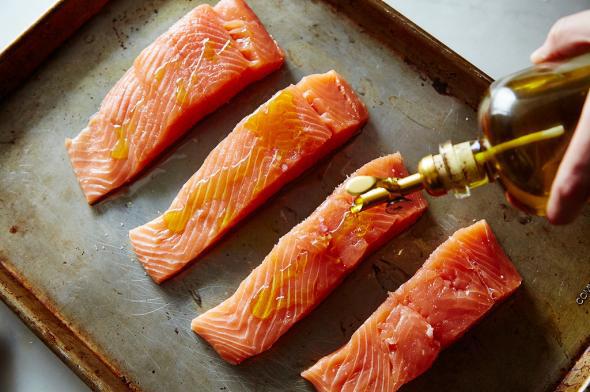This post originally appeared at Food52.
The most unfair implication of slow-roasting is the slowness part. Sure, there are plenty of benefits—gentler cooking, a cooler kitchen, a both technique- and zen-driven lifestyle—but speed (and, by association, weeknight-friendliness) isn’t one of them. Or is it?
Unlike slow-roasted pork or chicken or even tomatoes, the perks that come along with turning down the oven happen to come much faster with fish, as most things do. Fish needs a new marketing campaign: Fish is always fast. Its connective tissue and protein structure are more delicate than those of other meats, says Harold McGee, and should generally be cooked as little as possible.
And so, fish is the only case where slow-roasting can take as little as 15 minutes. Low-roasting would be more accurate than slow-roasting—we should start seeding a change in terminology, and tell Google about it.
There are all sorts of variations on the idea—Michel Bras and Paula Wolfert famously added a pan of boiling water to the bottom of the oven to help the fish steam; Alice Waters tops her slow-cooked fish with a perky lemon relish; and Food52’s Erin McDowell translates the method to a cold pan on the stovetop.
But perhaps the simplest, fastest, and most versatile slow-roasting technique comes from Sally Schneider in A New Way to Cook. All you need: a thin coat of olive oil, salt, and a 275-degree oven.

Photo by James Ransom
Schneider learned about the technique for salmon close to 20 years ago, she wrote to me, “So I asked, ‘What if I applied it to other fish?’ and tested them out to discover that the dead-simple technique works great for all sorts of fish and shellfish”—from striped bass and cod to sea scallops to steakier fish like tuna and swordfish.
Slow-roasting makes a beautifully tender, evenly cooked, not-one-bit-dry piece of fish. If you miss the 120-degree, just-starting-to-flake mark and take it out late, it will still be good—even carryover cooking after taking it out of the oven won’t outrun you, because there isn’t much velocity behind it. This makes the technique perfect for dinner parties and newer fish cooks, whom the “Fish is always fast” marketing will hopefully reach soon.
“Over the years, it’s proven to be an essential technique I’ve riffed on endlessly,” Schneider told me. “You slow-roast the fish, then embellish it any way you want or with whatever is on hand; therein lies the opportunity to improvise.” In her later version in The Improvisational Cook, she suggests all kinds of sauces, from fennel oil to brown butter and vinegar. I topped mine with Greek yogurt speckled with chives.
Years ago, I learned a memorable analogy about speed and cooking from my friend Anita Shepherd, after I burned a pan of bacon and had to ride my bike around Little Italy looking for another package late at night—this was before she became a vegan chef and coconut milk yogurt developer (and before I cooked bacon for dinner more often than I should).
She told me cooking is like coming up to a stop light. If you’re going slowly, it’s easy to hit your mark. If you’re going fast, you’d better hope that you have very good aim (and strong brakes). Low, slow roasting is fish’s built-in brake.

Photo by James Ransom
Sally Schneider’s Slow-Roasted Salmon (or Other Fish)
Slightly adapted from A New Way to Cook
Serves 4
1 teaspoon extra-virgin olive oil
1½ pounds thick salmon fillet, or other fish like striped bass or cod (1 large fillet or four 6-ounce fillets)
Kosher salt
A small bunch of fresh thyme sprigs (optional)
Chopped fresh herbs like chives, and Greek yogurt to finish (optional)
See the full recipe at Food52.
Got a genius recipe to share—from a classic cookbook, an online source, or anywhere, really? Please send it my way (and tell me what’s so smart about it) at kristen@food52.com.
More from Food52:
The Most Flavorful Zucchini Is Also the Simplest Make-Ahead Side
How to Know When Fish Is Done
How to Grill a Piece of Fish in 5 Minutes (and Nail It Every Time)
5 Tips for the Perfect Grilled Fish Sandwich
Russ Parsons’ Crisp-Skinned Salmon
The Best, 5-Minute Smoked Salmon Appetizer
